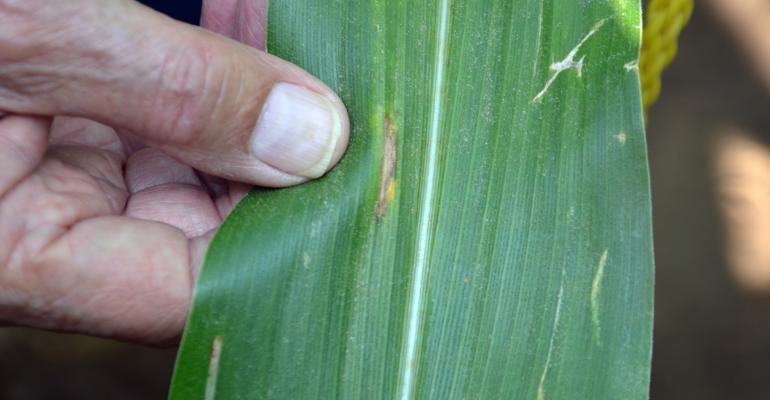Zero in on disease control

Corn Pest Beat: Know the disease and corn growth stages to make informed decisions about spraying fungicide.
Jun 23, 2022
I just found tar spot. My cousin 60 miles south found southern rust and gray leaf spot. Should I spray fungicides? When? Once or twice? Should my cousin spray?
The Indiana certified crop adviser panelists answering this question include Betsy Bower, agronomist for Ceres Solutions, Lafayette; Dan Quinn, Purdue Extension corn specialist; Greg Kneubuhler, G&K Concepts Inc., Harlan; and Bryan Overstreet, Purdue Extension educator, Jasper County.
Bower: Once you find a tar spot lesion, the disease has negatively impacted corn for two weeks. If it’s early in grain fill, apply a fungicide to stop it and slow reinfection. Even at R4 or dough stage, reach out to crops experts to see if you should spray. There are five to six weeks until black layer.
Southern rust can take corn from green to brown in seven to 10 days. Time from infection to seeing disease on the plant is much shorter than with tar spot. Consider stage of corn, susceptibility of each hybrid and value of corn to decide.
Once you see any disease lesion, you’re reducing photosynthetic capacity. The earlier the lesions start, the more yield you lose. Weather influences disease progress. With a high-dollar corn market and your investment, it’s not time to stop protecting corn.
Kneubuhler: The worst tar spot pressure is in the northern and western tier of counties. Damage is unwavering — don’t take it lightly. The key is to not ever allow it to get started. Once tar spot gets a foothold, it’s almost impossible to reverse it. If it comes in early, it will devastate yields. I would spray corn twice in this case: once late vegetative and once post tassel.
For your cousin, if southern rust and gray leaf spot are already showing up, make a fungicide application soon to hold it at bay. I would do my best to hold the pressure from increasing.
Overstreet: What growth stage is corn in? If it’s in dough stage, it’s late enough that spraying will do little good. How much tar spot do you see? Are conditions right for disease spread? The Tarspotter App can help. Each treatment will last about 30 days. If you’re respraying early to mid-August, you may only have time to spray once. The most effective time to spray for tar spot is at tasseling or shortly after.
I would recommend the same to your cousin. Look at each individual case. Check out the Purdue Field Crop Pathology Extension website.
Quinn: Depending on growth stage when you find tar spot and if there is high moisture and humidity, it may be worth spraying. The best time to spray for tar spot for the most consistent response is between VT and R2. If tar spot is severe and found before V10, it may be worth two fungicide applications. However, this is only recommended in certain situations. Scout consistently for tar spot to determine when disease is present and how severe it is. Ask if environmental conditions warrant significant disease spread.
Southern rust doesn’t overwinter in Indiana. Whether a fungicide application is needed depends on environmental conditions, disease movement and timing. Found in mid-July or early August, a fungicide is likely warranted.
If the field has a history of gray leaf spot, the hybrid has low levels of resistance and gray leaf spot lesions are approaching the ear leaf before tassel, a fungicide is likely needed at VT/R1. In Indiana, two fungicide applications are not needed for southern rust and gray leaf spot.

